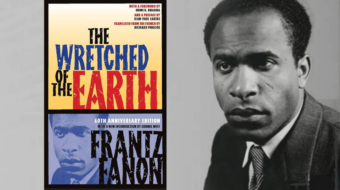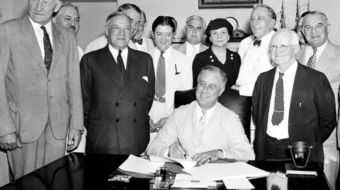
As people grapple with a planetary pandemic, an exciting new movie is premiering just in time to commemorate the 75th anniversary of the end of our last global conflagration. Enemy Lines is available to rent or own on April 24 shortly before the platinum jubilee of Victory in Europe or V-E Day, May 8, 1945, which signified the Allied victory over Hitler and Mussolini. Swedish director Anders Banke’s World War II movie also reminds us of the all but forgotten Mission Alsos, and in doing so provides film and war buffs with a highly entertaining history lesson.
To fully grasp the extraordinary nature of Major Kaminski’s (Ed Westwick) daring operation, imagine if a team of Nazi irregular soldiers had infiltrated New Mexico circa 1943 in order to “extract” nuclear physicist J. Robert Oppenheimer, chief of the Manhattan Project’s staff, from Los Alamos in order to bring the scientist back to the Fatherland in order to work on Germany’s “heavy water” experiments to create an atomic bomb.
In Enemy Lines, Kaminski is a U.S. Marine Major who leads a squad of British commandos into Nazi-occupied Poland in order to abduct Dr. Fabien (Kraków-born Pawel Delag). This action-packed classic is in fine cinematic company as it’s in the tradition of Robert Aldrich’s 1967 The Dirty Dozen starring Lee Marvin, 1970’s Kelly’s Heroes with Clint Eastwood, 1971’s Henry Hathaway-directed Raid on Rommel with Richard Burton, and 1965’s The Heroes of Telemark—all WWII movies about Allied special forces staging daring missions in Nazi-occupied territory. (While it’s widely known that Kirk Douglas starred in 1960’s Spartacus written by ex-Red Dalton Trumbo, he also starred in Telemark, co-written by another blacklisted, former Communist screenwriter, Ben Barzman.)
Kaminski mistakenly believes that Dr. Fabien is a rocket scientist, but the scientist eventually sets him straight. Fabien is actually researching something potentially far deadlier than V-2 missiles (which were devastatingly used during the Battle of Britain) for the Third Reich: An atomic bomb, which raises the stakes much higher in the WWII equivalent of an arms race that not only pitted the Brits and Yanks against the Germans but involved the Soviets, as well.
The Red Army is depicted in a complicated way in Enemy Lines, which is mostly set in Poland but was filmed largely on location in Belarus (co-producer Nadzeya Huselnikava hails from Minsk), which had been part of the USSR. Moscow-born actor/director Vladimir Epifantsev portrays Petrov, commanding officer of the Soviet soldiers who also want to get their hands on Fabien to use him to develop nuclear weapons for the Kremlin. However, the Russians eventually join their wartime allies to fight on the same side as the Americans and British against their common foe, the Nazis. Readers will recall that in 1939, while the Hitler-Stalin Non-Aggression Pact was in place, shortly after the Nazis invaded Poland, the Russians followed suit. However, after Berlin betrayed the USSR in 1941, the Red Army joined the Allied war effort, playing a decisive role in defeating fascism.
As if this isn’t enough, Polish partisans are tossed into the mix, enhancing the international flavor of this fast-moving drama. Resistance fighters join forces with the Allies as they valiantly fight against the better-armed Nazis in their effort to safely abscond with Dr. Fabien so that he can eventually become part of the aforementioned Manhattan Project, far from Poland’s countryside on the sands of New Mexico.
The Polish underground band includes Russian-born actress Ekaterina Vladimirova as the sexually liberated gun-toting guerrilla Sara. Her performance, which defies gender norms, may be the standout in the cast and the film’s most outstanding character.
Pawel Delag, a veteran of Polish productions as well as of Steven Spielberg’s 1993 Holocaust masterpiece Schindler’s List, also excels as Dr. Fabien, resembling Austrian actor Maximilian Schell in films such as that 1977 anti-fascist gem Julia. The character of Fabien seems suggested by Nobel Peace Prize winner Joseph Rotblat, the Polish physicist who was fortunate to leave his homeland in August 1939, shortly before Hitler invaded. By 1944 Rotblat went from London to the Los Alamos Laboratory as part of the British Mission to work on the Manhattan Project. Rotblat eventually rejected the arms race and co-won the Nobel Peace Prize in 1995 “for efforts to diminish the part played by nuclear arms in international affairs and, in the longer run, to eliminate such arms,” according to the award’s citation. The character apparently inspired by Rotblat in Enemy Lines may be so named as a reference to the “Fabian Socialists,” an idealistic wing of the British Left.
American viewers may be most familiar with Ed Westwick, who plays Enemy Lines’ lead character and previously co-starred in the Gossip Girl TV series and on the big screen in Clint Eastwood’s 2011 Hoover biopic J. Edgar and Alfonso Cuarón’s dystopian 2006 Children of Men. As the Polish-American Major Kaminski, the British-born actor delivers a solid performance as a hardboiled Marine dedicated to carrying out his perilous mission, no matter what the costs. Stateside audiences may also recognize Scottish actor John Hannah who plays Col. Preston and earlier acted in The Mummy film franchise and British pictures such as 1994’s Four Weddings and a Funeral.
Co-written by Michael Wright and Tom George, Enemy Lines has some interesting left-oriented dialogue, with references to “Uncle Joe”—a wartime nickname for Stalin—and Petrov telling one of his Red Army comrades he won’t reveal that the soldier “died fighting for the capitalists.” The issues of child soldiers and the impact of war on children are also alluded to, as are war crimes. Before many of the characters who get shot die the camera dwells on them, reminding us that, in the memorable words of General Sherman, “War is hell.” With an international cast and characters, this independent movie shot on location mostly in Belarus, plus some scenes lensed in the U.K., Enemy Lines has dialogue spoken in Polish and Russian with subtitles in English, which is the main language spoken throughout most of the movie.
Co-producer Nadzeya Huselnikava, founder of Nadia Productions, told VoyageLA in a 2019 interview: “Born and raised in Belarus, I am trying to bring two cultures and two countries together by combining the advanced Hollywood practices and originality of Belarus to create the unique and budget-friendly content for the worldwide appeal.”
Director Anders Banke has succeeded in doing this and more. Enemy Lines is an engrossing, tight, taut actioner that also touches upon the morality of war. Sharp-eyed, historically astute viewers will note what appears to be “Little Boy” in the background, the atomic bomb dropped on Hiroshima. This is an appropriate note to end this exciting, well-made commemoration of the 75th anniversary of V-E Day, with a reference to Victory Over Japan or V-J Day a few months later in 1945. As authoritarianism threatens us again at home and abroad, anti-fascist World War II films like Enemy Lines remind us of, as Frank Capra put it, “Why We Fight.” As we hunker down on the home front, watching the night Kaminski raided Poland serves as a reminder of what it took to defeat that last worldwide disaster, as we fight another global cataclysm 75 years later.
Enemy Lines will be available across all major transactional sites—iTunes/AppleTV, Amazon, Vudu, FandangoNOW, Cable OnDemand, Redbox, etc., starting Friday, April 24. The trailer can be viewed here.










